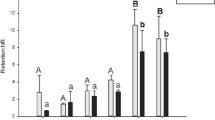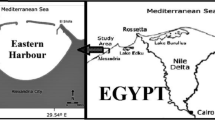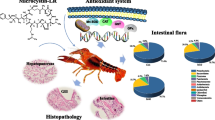Abstract
Mussel (Mytilus galloprovincialis (Lamarck, 1819)) is directly exposed to sea water contamination that elicits significant physiological and cellular response, although its extent mounted in aquaculture-reared in comparison to wild bivalve populations is scarcely known. Therefore, we have compared contamination biomarkers in mussels from reared (Marina farm) and wild, anthropogenically affected site (Vranjic Bay). While predictably, the levels of metals (Cu, Cd, Pb, Zn, Fe, and Hg) in whole bivalve tissues determined by atomic absorption spectrophotometry resulted in significantly higher concentrations in wild mussels, accompanied by elevated number of apoptotic cells in gills, the activity of multixenobiotic resistance defense mechanism (MXR), measured as the accumulation rate of model substrate rhodamine B (RB) gave contrasting results. The functional RB assay evidenced a lower MXR efflux activity in the gill tissue of wild mussels, indicating two possible scenarios that will need further focus: (1) persisting sea water pollution increased cell damage of bivalve gill cells and consequently led to leakage of the RB into cytoplasm and dysfunctional MXR efflux in wild mussels; or/and (2) a mixture of different toxic compounds present in Vranjic Bay sea water induced oversaturation of MXR efflux, inducing elevated accumulation of the dye. Consequently, it seems that an efficient physiological functioning of MXR in wild mussels is strongly hampered by existence of an unknown quantity of sea water pollutants that may endanger intrinsic organismal defense system and lead toward the enhancement of toxicity.




Similar content being viewed by others
References
Abdulla, A., Gomei, M., Hyrenbach, D., Notarbartolo-di-Sciara, G., & Agardy, T. (2009). Challenges facing a network of representative marine protected areas in the Mediterranean: prioritizing the protection of underrepresented habitats. ICES Journal of Marine Science, 66(1), 22–28.
Achard, M., Baudrimont, M., Boudou, A., & Bourdineaud, J. (2004). Induction of a multixenobiotic resistance protein (MXR) in the Asiatic clam Corbicula fluminea after heavy metals exposure. Aquatic Toxicology, 67(4), 347–357.
Alazemi, B., Lewis, J., & Andrews, E. (1996). Gill damage in the freshwater fish Gnathonemus petersii (Family: Mormyridae) exposed to selected pollutants: an ultrastructural study. Environmental Technology, 17(3), 225–238.
Amiard, J., Amiard-Triquet, C., Berthet, B., & Metayer, C. (1986). Contribution to the ecotoxicological study of cadmium, lead, copper and zinc in the mussel Mytilus edulis. Marine Biology, 90(3), 425–431.
Anselmo, H. M., van den Berg, J. H., Rietjens, I. M., & Murk, A. J. (2012). Inhibition of cellular efflux pumps involved in multi xenobiotic resistance (MXR) in echinoid larvae as a possible mode of action for increased ecotoxicological risk of mixtures. Ecotoxicology, 21(8), 2276–2287.
Bard, S. M. (2000). Multixenobiotic resistance as a cellular defense mechanism in aquatic organisms. Aquatic Toxicology, 48(4), 357–389.
Basaran, A. K., Aksu, M., & Egemen, O. (2010). Impacts of the fish farms on the water column nutrient concentrations and accumulation of heavy metals in the sediments in the eastern Aegean Sea (Turkey). Environmental Monitoring and Assessment, 162(1–4), 439–451.
Bošnjak, I., Zaja, R., Klobučar, R. S., Šver, L., Franekić, J., & Smital, T. (2013). Identification of ABC transporter genes in gonad tissue of two Mediterranean sea urchin species: black, Arbacia lixula L., and rocky, Paracentrotus lividus L. Bulletin of Environmental Contamination and Toxicology, 91, 415–419.
Bradford, M. M. (1976). A rapid and sensitive method for the quantitation of microgram quantities of protein utilizing the principle of protein-dye binding. Analytical Biochemistry, 72(1), 248–254.
Châtel, A., Hamer, B., Jakšić, Ž., Vucelić, V., Talarmin, H., Dorange, G., et al. (2011). Induction of apoptosis in mussel Mytilus galloprovincialis gills by model cytotoxic agents. Ecotoxicology, 20(8), 2030–2041.
Chen, F., Vallyathan, V., Castranova, V., & Shi, X. (2001). Cell apoptosis induced by carcinogenic metals. Molecular and Cellular Biochemistry, 222(1–2), 183–188.
Claudet, J., & Fraschetti, S. (2010). Human-driven impacts on marine habitats: a regional meta-analysis in the Mediterranean Sea. Biological Conservation, 143(9), 2195–2206.
Cornwall, R., Toomey, B. H., Bard, S., Bacon, C., Jarman, W. M., & Epel, D. (1995). Characterization of multixenobiotic/multidrug transport in the gills of the mussel Mytilus californianus and identification of environmental substrates. Aquatic Toxicology, 31(4), 277–296.
Della Torre, C., Bocci, E., Focardi, S. E., & Corsi, I. (2014). Differential ABCB and ABCC gene expression and efflux activities in gills and hemocytes of Mytilus galloprovincialis and their involvement in cadmium response. Marine Environmental Research, 93, 56–63.
Epel, D., Luckenbach, T., Stevenson, C. N., MacManus-Spencer, L. A., Hamdoun, A., Smital, et al. (2008). Efflux transporters: newly appreciated roles in protection against pollutants. Environmental Science & Technology, 42(11), 3914–3920.
Faria, M., Navarro, A., Luckenbach, T., Piña, B., & Barata, C. (2011). Characterization of the multixenobiotic resistance (MXR) mechanism in embryos and larvae of the zebra mussel (Dreissena polymorpha) and studies on its role in tolerance to single and mixture combinations of toxicants. Aquatic Toxicology, 101(1), 78–87.
Fiorini, R., Pagliarani, A., Nesci, S., Pirini, M., Tucci, E., & Ventrella, V. (2012). Structural and functional changes in gill mitochondrial membranes from the Mediterranean mussel Mytilus galloprovincialis exposed to tri-n-butyltin. Environmental Toxicology and Chemistry, 31(4), 877–884.
Franzellitti, S., Capuzzo, A., Viarengo, A., & Fabbri, E. (2011). Interactive effects of nickel and chlorpyrifos on Mediterranean mussel cAMP-mediated cell signaling and MXR-related gene expressions. Comparative Biochemistry and Physiology, Part C: Toxicology & Pharmacology, 154(4), 377–382.
Garen, P., Robert, S., & Bougrier, S. (2004). Comparison of growth of mussel, Mytilus edulis, on longline, pole and bottom culture sites in the Pertuis Breton, France. Aquaculture, 232(1–4), 511–524.
National Gazette (NN 037/2010). Plan of the monitoring of the sea and shellfish quality in production areas and areas for shellfish purification (Plan praćenja kakvoće mora i školjkaša na proizvodnim područjima i područjima za ponovno polaganje živih školjkaša). Resource document. http://hidra.srce.hr/arhiva/263/55195/narodne-novine.nn.hr/clanci/sluzbeni/2010_03_37_956.html. Accessed 25 June 2013.
Goldstone, J., Hamdoun, A., Cole, B., Howard-Ashby, M., Nebert, D., Scally, M., et al. (2006). The chemical defensome: environmental sensing and response genes in the Strongylocentrotus purpuratus genome. Developmental Biology, 300(1), 366–384.
Gottesman, M. M. (2002). Mechanisms of cancer drug resistance. Annual Review of Medicine, 53(1), 615–627.
Grigorakis, K., & Rigos, G. (2011). Aquaculture effects on environmental and public welfare—the case of Mediterranean mariculture. Chemosphere, 85(6), 899–919.
Guillermo, L. V., Pereira, W. F., De Meis, J., Ribeiro-Gomes, F. L., Silva, E. M., Kroll-Palhares, K., et al. (2009). Targeting caspases in intracellular protozoan infections. Immunopharmacology and Immunotoxicology, 31(2), 159–173.
Haimeur, A., Conseil, G., Deeley, R., & Cole, S. (2004). The MRP-related and BCRP/ABCG2 multidrug resistance proteins: biology, substrate specificity and regulation. Current Drug Metabolism, 5(1), 21–53.
Halpern, B. S., McLeod, K. L., Rosenberg, A. A., & Crowder, L. B. (2008). Managing for cumulative impacts in ecosystem-based management through ocean zoning. Ocean Coast Manage, 51(3), 203–211.
Hamdoun, A. M., Cherr, G. N., Roepke, T. A., & Epel, D. (2004). Activation of multidrug efflux transporter activity at fertilization in sea urchin embryos (Strongylocentrotus purpuratus). Developmental Biology, 276(2), 452–462.
Hietanen, B., Sunila, I., & Kristoffersson, R. (1998). Toxic effects of zinc on the common mussel Mytilus edulis L. (Bivalvia) in brackish water. 1. Physiological and histopathological studies. Annales Zoologici Fennici, 25, 341–347.
Ivanina, A. V., & Sokolova, I. M. (2008). Effects of cadmium exposure on expression and activity of P-glycoprotein in eastern oysters, Crassostrea virginica Gmelin. Aquatic Toxicology, 88(1), 19–28.
Jakobi, S. C., de Oliveira Ribeiro, C. A., Burckhardt, P. L., de Oliveira, L. T., & Pessatti, M. L. (2012). Chemosensitizer effect of the crude oil water solution fraction on multixenobiotic resistance mechanism of the mussel Perna perna exposed to tributyltin. Brazilian Journal of Aquatic Science and Technology, 16(1), 69–77.
Jakšić, Ž., Batel, R., Bihari, N., Mičić, M., & Zahn, R. K. (2005). Adriatic coast as a microcosm for global genotoxic marine contamination––a long-term field study. Marine Pollution Bulletin, 50(11), 1314–1327.
Klobučar, G. I. V., Štambuk, A., Hylland, K., & Pavlica, M. (2008). Detection of DNA damage in haemocytes of Mytilus galloprovincialis in the coastal ecosystems of Kaštela and Trogir bays, Croatia. Science of the Total Environment, 405(1), 330–337.
Koudrine, A. (1998). Trace elements and apoptosis. Journal of Trace Elements in Medicine and Biology, 12(2), 65–76.
Kurelec, B. (1992). The multixenobiotic resistance mechanism in aquatic organisms. Critical Reviews in Toxicology, 22(1), 23–43.
Labat-Moleur, F., Guillermet, C., Lorimier, P., Robert, C., Lantuejoul, S., Brambilla, E., et al. (1998). TUNEL apoptotic cell detection in tissue sections: critical evaluation and improvement. Journal of Histochemistry & Cytochemistry, 46(3), 327–334.
Leslie, E. M., Deeley, R. G., & Cole, S. P. (2005). Multidrug resistance proteins: role of P-glycoprotein, MRP1, MRP2, and BCRP (ABCG2) in tissue defense. Toxicology and Applied Pharmacology, 204(3), 216–237.
Luckenbach, T., & Epel, D. (2005). Nitromusk and polycyclic musk compounds as long-term inhibitors of cellular xenobiotic defense systems mediated by multidrug transporters. Environmental Health Perspectives, 113(1), 17–24.
Luckenbach, T., & Epel, D. (2008). ABCB-and ABCC-type transporters confer multixenobiotic resistance and form an environment-tissue barrier in bivalve gills. American Journal of Physiology - Regulatory, Integrative and Comparative Physiology, 294(6), R1919–R1929.
Mechetner, E. B., & Roninson, I. B. (1992). Efficient inhibition of P-glycoprotein-mediated multidrug resistance with a monoclonal antibody. Proceedings of the National Academy of Sciences, 89(13), 5824–5828.
Mičić, M., Bihari, N., Labura, Ž., Müller, W. E., & Batel, R. (2001). Induction of apoptosis in the blue mussel Mytilus galloprovincialis by tri-n-butyltin chloride. Aquatic Toxicology, 55(1), 61–73.
Minier, C., Akcha, F., & Galgani, F. (1993). P-glycoprotein expression in Crassostrea gigas and Mytilus edulis in polluted seawater. Comparative Biochemistry and Physiology - Part B: Biochemistry & Molecular Biology, 106(4), 1029–1036.
Minier, C., Eufemia, N., & Epel, D. (1999). The multi-xenobiotic resistance phenotype as a tool to biomonitor the environment. Biomarkers, 4(6), 442–454.
Minier, C., Moore, M., Galgani, F., & Claisse, D. (2006). Multixenobiotic resistance protein expression in Mytilus edulis, M. galloprovincialis and Crassostrea gigas from the French coasts. Marine Ecology Progress Series, 322, 143–154.
Mueller, W. E., Steffen, R., Rinkevich, B., Matranga, V., & Kurelec, B. (1996). The multixenobiotic resistance mechanism in the marine sponge Suberites domuncula: its potential applicability for the evaluation of environmental pollution by toxic compounds. Marine Biology, 125(1), 165–170.
Neyfakh, A. A. (1988). Use of fluorescent dyes as molecular probes for the study of multidrug resistance. Experimental Cell Research, 174(1), 168–176.
Nikaido, H. (2009). Multidrug resistance in bacteria. Annual Review of Biochemistry, 78, 119.
Penninger, J. M., & Kroemer, G. (2003). Mitochondria, AIF and caspases-rivaling for cell death execution. Nature Cell Biology, 5(2), 97–99.
Pulido, M. D., & Parrish, A. R. (2003). Metal-induced apoptosis: mechanisms. Mutation Research: Fundamental and Molecular Mechanisms of Mutagenesis, 533(1), 227–241.
Rana, S. V. S. (2008). Metals and apoptosis: recent developments. Journal of Trace Elements in Medicine and Biology, 22(4), 262–284.
Read, P., Fernandes, T., & Miller, K. (2001). The derivation of scientific guidelines for best environmental practice for the monitoring and regulation of marine aquaculture in Europe. Journal of Applied Ichthyology, 17(4), 146–152.
Sakellari, A., Karavoltsos, S., Theodorou, D., Dassenakis, M., & Scoullos, M. (2013). Bioaccumulation of metals (Cd, Cu, Zn) by the marine bivalves M. galloprovincialis, P. radiata, V. verrucosa and C. chione in Mediterranean coastal microenvironments: association with metal bioavailability. Environmental Monitoring and Assessment, 185(4), 3383–3395.
Sapkota, A., Sapkota, A. R., Kucharski, M., Burke, J., McKenzie, S., Walker, P., et al. (2008). Aquaculture practices and potential human health risks: current knowledge and future priorities. Environment International, 34(8), 1215–1226.
Sheehan, D., & Power, A. (1999). Effects of seasonality on xenobiotic and antioxidant defence mechanisms of bivalve molluscs. Comparative Biochemistry and Physiology, Part C: Toxicology & Pharmacology, 123(3), 193–199.
Smital, T., & Kurelec, B. (1997). Inhibitors of the multixenobiotic resistance mechanism in natural waters: in vivo demonstration of their effects. Environmental Toxicology and Chemistry, 16(10), 2164–2170.
Smital, T., & Kurelec, B. (1998). The chemosensitizers of multixenobiotic resistance mechanism in aquatic invertebrates: a new class of pollutants. Mutation Research: Fundamental and Molecular Mechanisms of Mutagenesis, 399(1), 43–53.
Smital, T., Luckenbach, T., Sauerborn, R., Hamdoun, A. M., Vega, R. L., & Epel, D. (2004). Emerging contaminants—pesticides, PPCPs, microbial degradation products and natural substances as inhibitors of multixenobiotic defense in aquatic organisms. Mutation Research, 552(1–2), 101–117.
Smital, T., Sauerborn, R., & Hackenberger, B. K. (2003). Inducibility of the P-glycoprotein transport activity in the marine mussel Mytilus galloprovincialis and the freshwater mussel Dreissena polymorpha. Aquatic Toxicology, 65(4), 443–465.
Sokolova, I. (2009). Apoptosis in molluscan immune defense. I.S.J., 6, 49–58.
Stergiou, K. I., Tsikliras, A. C., & Pauly, D. (2009). Farming up Mediterranean food webs. Conservation Biology, 23(1), 230–232.
Stevenson, C. N., MacManus-Spencer, L. A., Luckenbach, T., Luthy, R. G., & Epel, D. (2006). New perspectives on perfluorochemical ecotoxicology: inhibition and induction of an efflux transporter in the marine mussel, Mytilus californianus. Environmental Science & Technology, 40(17), 5580–5585.
Šrut, M., Štambuk, A., Pavlica, M., & Klobučar, G. (2010). Cage exposure of European sea bass (Dicentrarchus labrax) for in situ assessment of pollution-related genotoxicity. Arhiv za Higijenu Rada i Toksikologiju, 61, 29–36.
Zaja, R., Klobučar, R. S., & Smital, T. (2007). Detection and functional characterization of Pgp1 (ABCB1) and MRP3 (ABCC3) efflux transporters in the PLHC-1 fish hepatoma cell line. Aquatic Toxicology, 81(4), 365–376.
Zhang, L., Liu, X., You, L., Zhou, D., Wu, H., Li, L., et al. (2011). Metabolic responses in gills of Manila clam Ruditapes philippinarum exposed to copper using NMR-based metabolomics. Marine Environmental Research, 72(1), 33–39.
Žaja, R., Munić, V., & Smital, T. (2008). Cloning and mRNA expression analysis of an ABCG2 (BCRP) efflux transporter in rainbow trout (Oncorhynchus mykiss) liver and primary hepatocytes. Marine Environmental Research, 66(1), 77–79.
Acknowledgments
This study was fulfilled under and supported by the Croatian Ministry of Science, Education and Sport (Project Nos. 001-0000000-3633 and 058-0582261-2246).
Author information
Authors and Affiliations
Corresponding author
Rights and permissions
About this article
Cite this article
Bošnjak, I., Hrabar, J., Petrić, M. et al. Multixenobiotic Resistance Mechanism in Gills of Reared vs. Wild Mediterranean Mussel Mytilus galloprovincialis (Lamarck, 1819). Water Air Soil Pollut 225, 2073 (2014). https://doi.org/10.1007/s11270-014-2073-z
Received:
Accepted:
Published:
DOI: https://doi.org/10.1007/s11270-014-2073-z




